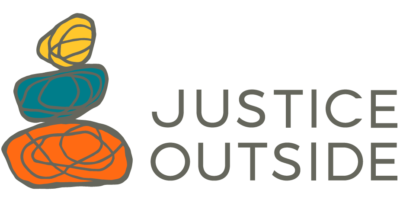In 2018, I was on a sea kayaking trip to paddle around Angel Island in the San Francisco Bay Area. The adventure started calm but about 15 minutes in, my partner and I found ourselves suddenly capsized in the waters. Panic gripped me as the boat flipped, plunging us into the water. I was beginning to feel overwhelmed. I was less than two months into Justice Outside’s Outdoor Educators Institute program, but I had already forged strong bonds with my fellow adventurers. Rachael Meyers, another participant, drifted her kayak reassuringly close to me. Her calm demeanor and firm and gentle guidance cut through the turmoil. “Breathe,” she said, with a simplicity that resonated deeply. Her words became a lifeline.
The true impact of this terrifying experience dawned on me when we finally reached the safety of the shore. At that age, the incessant chatter of self-doubt often plagued my thoughts—”Do people think I am a failure?” Yet, amid the adrenaline and relief of being back on solid ground, I noticed a shift. The usual self-critical thoughts seemed to fade into insignificance. It was the communal spirit fostered within the Outdoor Educators Institute that played a pivotal role in me feeling that I was in the right place, seeking the right things in life.
Spending time outdoors has been tied to better physical and mental health. We’ve even seen medical professionals prescribing time in nature to their patients in recent years. However, little has been said about the power of using the outdoors to build community. The United States is facing an epidemic of loneliness and isolation. As a 2023 report from Health and Human Services shows this has implications for all aspects of our lives, from cognitive ability to the economic prosperity of our communities. My experiences as an outdoor educator have shown me that the outdoors are an exceptional tool for building community, fostering belonging, and fighting isolation.
Since graduating from the Outdoor Educators Institute, I have been an active part of the alumnx community and working with Justice Outside to support young adults who join the program. As the coordinator for the program, I have the chance to work with young people who are interested in learning outdoors skills. Most of the participants come from Black, Indigenous, and Communities of Color. Many have never had the opportunity to engage in kayaking, backpacking, hiking and climbing, learning Wilderness First Aid, fishing, and the many other skills we learn through the program. They value these skills and opportunities deeply, but time and time again, I hear them say that what matters most to them is the ability to be with other people of color and build community.
The Outdoor Educators Institute is specifically designed to help you find community. It’s not just you going outdoors with a bunch of people. It’s like you’re going outside with community, with other people who have experiences and identities like you and have faced similar barriers as you in accessing the outdoors. In that shared place, we know we can be safe, we know that we’re surrounded by people who get it. That’s so powerful for young people of color who are often told they don’t belong in the outdoors or don’t know enough to connect with nature. We’re offered unsolicited advice and tips on everything outdoors, from gear to foraging. Yet, I know that we are all connected to the outdoors from childhood. Our communities and families are deeply rooted in nature. Whether they worked in farming or celebrated birthdays in family picnics, families of color have been in community with nature since the beginning of time. It’s our medicine, our healing place, our source of food. Programs where we can gather in that shared understanding and acknowledgement lend to a space where we support each other in growth. Spaces like this are powerful and needed.
It makes my heart full to hear what participants in our program experience. At every graduation ceremony, I feel moved by the sense of belonging we’ve fostered in them—belonging to nature, belonging to community, and belonging to themselves. Often, the quiet or shy participants are the people who share most deeply and wholeheartedly what the experience meant for them at graduation. It gives me joy and hope every time someone feels empowered, connected, and hopeful because of the space I helped create for them. All the experiences and the training that people receive are great, but I think oftentimes young people come to the program looking for community and leave with that. Even if they weren’t looking for community, they realize that they needed it. They needed to be surrounded by other people of color in the outdoors.
More than 200 young people in the Bay Area and Central Valley have gone through the Outdoor Educators Institute. The program recently launched in Seattle for the first time as well. While many organizations around the country are working to expand access to the outdoors for people of color, outdoor recreation continues to be white dominated. We have an opportunity to do more, to work towards not only equal and safe access but joyful existence for Black, Indigenous, and People of Color in nature. That can start with educational and community-building programs like the one I work with.
For people of color, outdoor recreation and activities are not just about exploring the outdoors; it is also about forging connections and finding strength in community. The Outdoor Educators Institute provided me with a sanctuary with collective support and camaraderie shared among us adventurers. That’s why I work every day to recreate that community for other young people of color.
Laura Hernandez (they/them) is the Bay Area program coordinator for Justice Outside’s Outdoor Educators Institute, which trains young adults in outdoors and leadership skills.

